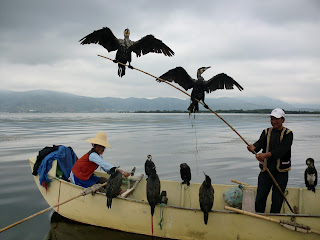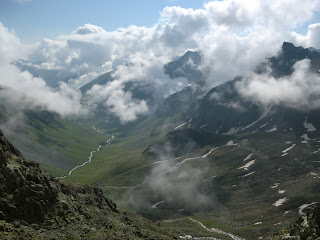“...travellers should be aware of Western Tuva’s fearsome reputation for wild lawlessness and unprovoked knife attacks.” Lonely Planet
“It’s like the Wild West; we came across stories of locals attacking visitors, throwing stones on their vehicles... you should not go there” English traveler
“In Tuva there is a serious problem of alcohol and violence. I never dare going there” Russian ecologist & mountain guide
“Wandering Kyzyl’s streets after dark without local company is not recommended” Lonely Planet
“...Tuva(n) people (are) bad, (and) dangerous.” A Tuvan person
“...Wow man, they can sing from their throat!” A good dear friend & musician
Ok, let’s go to Tuva.
We’re leaving Abakan behind and driving south. Last police check – nearly a border control: passports, car documents, registration and declaration. The guard needs to confirm that we are indeed intending to enter Tuva.
- Are we..?
After days we’re approaching out of the endless Siberian plains – goodbye claustrophobic forests. Bare mountains rise up, wild and rigid, far in the distance. Birds of prey circling the sky above and wild horses grazing on the horizon. Down there is Mongolia, in between is Tuva – Definitely picturesque.
310,000 Tuvans are living in an area as big as England. 100,000 of them in Kyzyl, the capital, and the rest are nomadic or semi nomadic. None of them would want me to say that but they’re pretty similar to their Mongolian neighbours; they live nomadic life style, they ride horses, they live in Yurts, drink salty tea, eat mutton and they love music.
And so, this is what we’ve been planning for Tuva: find nomads, ride their horses, stay in a Yurt, try their food and listen to their music – Easy...?
Part one: Anyone’s Nomad?
We’re arriving into Kyzyl and starting to ask questions. Is anyone here nomadic? Or a Horseman? Any Musicians perhaps? We hear no word (and no sound) but the warm recommendations to sleep in a safe compound and stay away from trouble.
Tired and fruitless we’re retreating to our hiding place for some sleep.
No one tried to kill us during the night. In the morning, fresh and motivated, we decided to revise our tactics and focus our search only on music. Music will bring the answers to everything, I say. Yeah, poetic.
And indeed, in the local community centre we find the following: (1) the best musicians of Tuva (and they’re all great people) (2) An invite to join their rehearsal for the new Tuvan national anthem. (3) Djenia, a nomad and a horseman who’s inviting us to his family Yurt camp in the mountains and (4) Sean, American-Tuvan who’s telling us the story of the new Tuvan national anthem. – What a hit.
Part two: The Culture
Couple of hours later and we’re on the move again, driving west, into the Taiga.
We’re following Djenia’s Vaz through rivers and passes, valleys and forests. There are no roads here, no electricity or mobile phone signal and no signs of time to remind us that thousands of years passed since humans started to settle the earth. This is nomads’ territory.
There, far in the distance, three riders are approaching to greet us. And over the hill a young boy on a majestic horse is leading a flock of wooly sheep. And then a clear spring, decorated with colourful prayer flags. It’s a beautiful journey. Suddenly, tucked between conifer doted mountain slopes, the Yurt camp appears.
In the Yurt, a white rounded shelter, young girls make cream and butter. They’re inviting us in. We taste various products and sample an alcoholic drink while our horses are being saddled.
 |
| Nomads |
 |
| Cheese making |
 |
| Jen on a horse |
It’s a great day. We’re among nomads, riding their horses, eating their food and getting to know their life style. But I want to get an insight on their culture nowadays.
In the evening we’re sitting around the fire with Anehak, Djenia’s wife. She studied in Abakan University and speaks fluent English and French; excellent opportunity for a chat. So I’m asking about life in Tuva; about culture, the love of music and the close relationship with nature. Then we speak about social issues: the massive unemployment rates, alcoholism and the bad reputation of violence and depression.
I’m sadly learning a lot.
This is another Avatar case where the land is full of natural resources to mine and a huge fortune to make. Like the other stories, the bully will soon show up to take it all and leave the weak – the locals – with nothing.
So the Russians came. The natives were too primitive and incapable so someone had to take control. Someone had to help them to become more progressive, more educated, more modern – more Russian.
The Russians did what was necessary: Nomads were forced to abandon their lifestyle and relocate into towns, the education system has been reformed, political power and the administration are being transferred to Moscow and local leadership dispersed. Now, when Tuva is nearly Russian, it’s time to start harvesting those gold mines.
The land has been ‘leased’ to Russian constructors who employ Chinese workers. When the entire budget is routed to the mine fields there’s nothing left for local development. There’s no investment, no infrastructure and no employment opportunities. Many ex-nomads became poor, jobless and drunk. Very drunk.
Anything left for the future? I ask.
“The only thing we’ve got left” – replies Anehak – “our culture”.
*
4 days later and the Naadam festival is about to begin. Horseracing, archery, wrestling, a Yurt contest and live music are all part of the celebration. It’s a colourful festival with traditional customs, local food and plenty of dancing. Tuvan culture is definitely alive and kicking, and tonight, as final verification, we’ll be witnessing the formal introduction of the new Tuvan national anthem.
Part 3: The National Anthem
I’m exhausted. So far I’ve been driving through rivers and mountains, staying in Yurts, riding horses, celebrating, dancing, hiking, freezing, thawing, socialising, experiencing, learning, researching, sympathising and all awhile I’ve been eating mainly boiled mutton. Travelling’s a hard life. But tonight is the piece de resistance. Tonight is the premiere. Tonight the National philharmonic of Tuva will formally introduce the new national anthem.
With nationality being the pressing issue and music being ordinary obsession National Anthem is exactly what Tuvans need.
So here’s the story of the national anthem.
‘I am Tuvan’ has been the most popular folk hymn for years. Everybody knows it, everybody’s loves it and naturally it should be the official National Anthem of Tuvan. But it’s actually Mongolian. It was written by Tuvans who happen to live, quite simply, on the other side of the border.
This little geographic issue can immediately raise questions on copyrights and can lead to an unpleasant diplomatic disagreement with Mongolia around a stolen song. No; the tiny republic of Tuva wouldn’t want to provoke their dear neighbours from the south.
So the best Tuvan composers gathered together and wrote a great piece of music. And it was indeed a great piece, tells Sean. But this is not how an anthem should be born – he adds. A true anthem should come from the people, from the public, rather than be imposed and chosen by a dedicated panel of artists and politicians. Sean man, I Agree.
The solution was so simple and daring that I truly and honestly loved it: Let’s invite the copywriters of ‘I am Tuvan’, ask their permission to use it as the new Anthem and tell the Mongolians to bugger off.
Evening, concert hall. 5 cups of coffee, 10 Bounty bars (sugar, sugar. Give me more sugar), getting the best seats from Anehak and I’m ready for the best show in town.
This is an amazing concert. A long line of the best musicians of Tuva is getting on the stage, dressed in traditional clothes, backed by popular guests from the past contributing from their repertoire. Traditional instruments are blending with electric guitars, throat singing with vocal harmonies, strings, percussions, double bass, flutes and guitars. The evening comes to a close when they are all joining forces to perform the anthem. Bravo – Excellent gig, wonderful anthem.
*
Ok, so this is not the most uplifting traveller’s story but I love the message: keep on moving, keep on playing, keep on with the music and save your culture. Good luck Tuva.
Jen & Noam Ben Tsion
more pictures and stories in our website www.landroveroverland.co.uk













































































